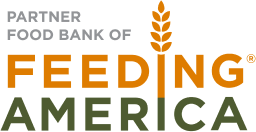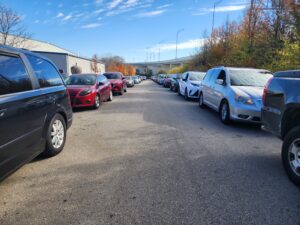Incarceration and Food Insecurity
Ex-Offenders Face Systemic Barriers to Reentering Society, Most are Food Insecure
By Amber Wright, Marketing
The incarceration rate in the United States is at its lowest since 1995, yet nearly 7 million US citizens are incarcerated or under community control at any given time.
Roughly 600,000 people are released from prison every year and these barriers and inequities carry over not only for them and their families, but also the communities to which they return.
For this blog, we will look at the nutritional well-being among formerly incarcerated individuals. 91% of people beginning their transition out of imprisonment report not having regular access to nutritious food. Long after release, they still remain twice as likely to be food insecure. Reentering society presents several barriers to gaining meaningful employment, leading to high rates of food insecurity and ultimately higher rates of recidivism and healthcare expenditures.
Importance of Proper Nutrition
Inadequate nutrition has been linked to several consequences such as:
- Obesity, heart disease, stroke, type 2 diabetes, some cancers, and deficits in brain function (CDC)
- Worsening mood disorders like depression and anxiety (Harvard)
- Hypertension and osteoporosis (USDA)
- Hyperactivity, disciplinary problems, psychological problems, and criminal behavior (DOJ)
- Increase of premature deaths
Stable access to healthy foods is crucial for both physical and mental well-being. Just as school children affected by hunger display poor performance and difficulty learning in school, adults suffer the same outcomes in the workplace.
If proper nutrition remains out of reach, it can be difficult to retain employability. Coupled with new or preexisting health conditions, this can generate avoidable healthcare expenses footed by the state.
Research reveals poor diets account for 20% of healthcare costs from heart disease, stroke, and diabetes. That equates to about $50 billion that could have been avoided.
There are several factors unique to previously incarcerated individuals that hinder access to a sufficient diet.
Collateral Consequences
Sentences might end, but the consequences of incarceration do not. For those who are released each year, most find significant barriers to getting back on their feet. They struggle to find adequate housing, employment, and living wages. These necessities are crucial for individuals to successfully reenter society instead of returning to the system.
Legally sanctioned restrictions and disabilities resulting from a conviction are known as “collateral consequences.” More than 47,000 collateral consequences have been identified in state and federal law, barring formerly incarcerated people from rights normally granted to American citizens. These may negatively affect access to housing, employment, professional licensure, property rights, mobility and even access to public benefits.
Barriers to Housing
Federal law currently bars access to public housing for people with certain types of convictions and grants private landlords the ability to deny anyone with a criminal background. It is not surprising that a third of people released from prison wind up in homeless shelters. Even those who have been incarcerated only once are 7 times more likely to be homeless than the general populations. It is 13 times more likely for anyone incarcerated more than once, and even higher in both categories for people of color and women.
Legislation punishes homelessness even more by criminalizing things like sleeping in public spaces, panhandling and public urination, which entraps hordes of people in the cycle of poverty while increasing recidivism rates. Even if former inmates are lucky enough to secure housing, they often find themselves limited to low-income, redlined neighborhoods. This increases the likelihood of living in a food desert and raises the chance of food insecurity.
Barriers Employment
Several social and legal barriers make it just as difficult for returning citizens to find employment. The first time data was released on the subject in 2018 by the Prison Policy Initiative, it revealed that unemployment for those leaving incarceration was an astounding 27%. Not only is that 5 times higher than the general population, but it exceeds the rate of any economic crisis, including the Great Depression. More than half of people released from prison remain out of work for at least a year.
One study found that state and federal law restricted ex-offenders from obtaining licensing required for various forms of employment. It discovered more than 12,000 restrictions for individuals with any type of felony and more than 6,000 restrictions based on misdemeanors. Surveys suggest most private employers are unwilling to hire someone who has served a prison sentence and 87% of employers conduct background checks.
Social stigma may suggest that people reentering society are not looking for work, but recent analysis indicates otherwise. For people between the ages of 25-44, data listed 93.3% of ex-offenders were either employed or actively looking for work, while only 83.8% of the general population fell into the same category. Low employment rates are more related to the systemic barriers they face rather than a lack of desire to work. Like housing barriers, people of color and women are affected the most.
Barriers to Benefits
Barriers have also been put in place hindering access to public benefits such as the Supplemental Nutrition Assistance Program (SNAP) and Temporary Assistance for Needy Families (TANF).
In 1996 federal law banned anyone with a felony drug conviction from receiving SNAP benefits. Since then, most states have either dropped the ban entirely or allowed assistance on the condition of regular drug testing and treatment. However, South Carolina still has the full ban in place.
The additional requirements put in place by states who have modified the ban not only accrue additional costs for the state, but they add strain to the individuals in fulfilling them. Already having a harder time finding employment, they must now limit their availability to make regular appointments.
When accessible, public benefits improve the health of recipients as well as cut costs in other areas. For example, SNAP has shown to reduce healthcare costs while improving the overall health of recipients and reducing food insecurity by 30%. At the same time, studies for even the modified ban on access to these benefits proved to increase recidivism instead.
Why This Matters
It’s not difficult to see how all these factors lead to food insecurity. If someone is unable to find housing or employment, it’s unlikely they will have regular access to healthy foods. Poor nutrition escalates physical and mental health conditions, decreasing employability and overall quality of life. Under these conditions, it is no surprise that both recidivism and poverty rates remain high.
It has been estimated that between 1980 and 2004 overall poverty in America would have dropped 20% if not for mass incarceration.
Poor nutrition exacerbates behavioral issues and aggression. When people have served their sentence, they continue to be punished with collateral consequences and social stigma, resulting in barriers to housing and employment. This increases recidivism and decreases social productivity for everyone.
Instead of funding being spent on public assistance and programs to help people reenter society (or avoid arrest completely,) it is often used to house those who are unable to overcome these challenges.
Reducing recidivism helps everyone. It is essential that ex-offenders be granted the same accessibility to these basic needs to make it happen. More programs should be put in place not only for their benefit, but for that of their families and the overall well-being of society.





No comment yet, add your voice below!